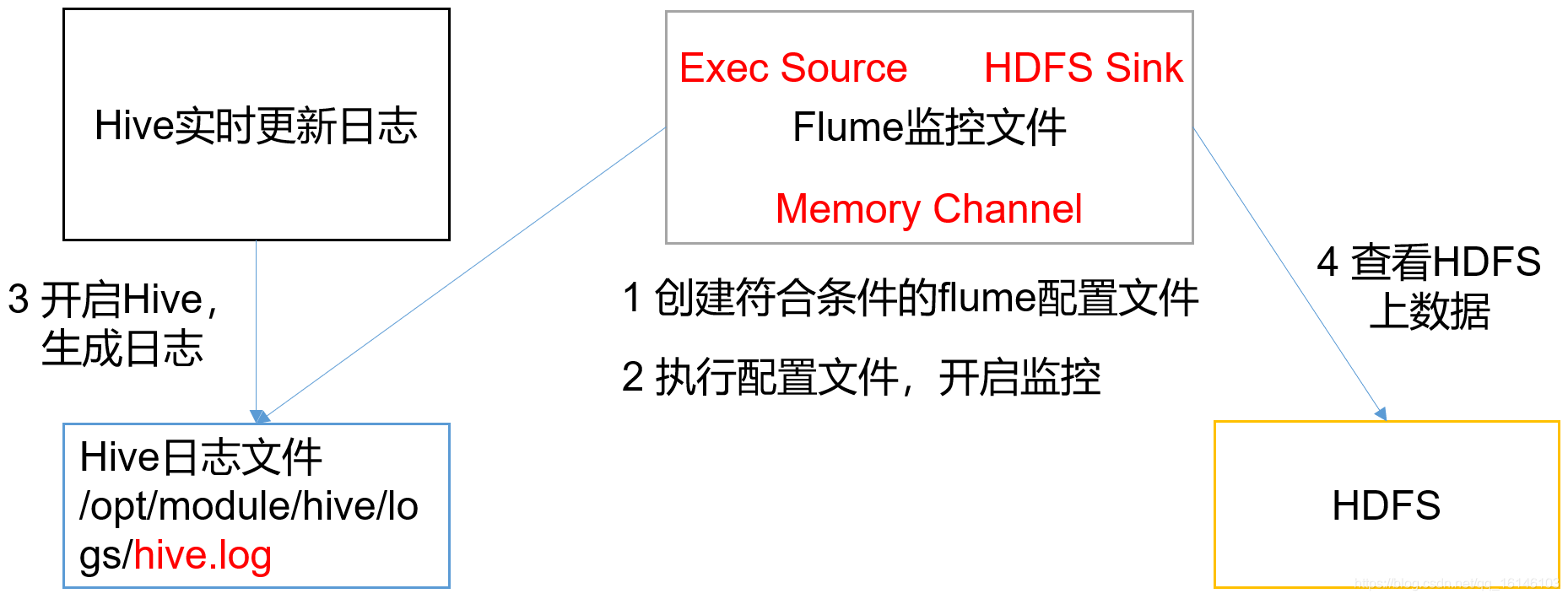上一篇我们已经简单的介绍了Flume,那么这一篇文章博主继续为大家介绍如何实时读取本地/目录文件到HDFS上。
目录
此部分所需要的文档,博主已经打包上传到百度云。如有需要请自行下载:
链接:https://pan.baidu.com/s/11KET693o47XR2WRXhbzFAA
提取码:n4fl
一. 实时读取本地文件到HDFS
1.1需求:
实时监控Hive日志,并上传到HDFS中
1.2 需求分析

1.3 实现步骤
1. Flume要想将数据输出到HDFS,必须持有Hadoop相关jar包
将
commons-configuration-1.6.jar、
hadoop-auth-2.7.2.jar、
hadoop-common-2.7.2.jar、
hadoop-hdfs-2.7.2.jar、
commons-io-2.4.jar、
htrace-core-3.1.0-incubating.jar
拷贝到/opt/module/flume/lib文件夹下。

2. 创建flume-file-hdfs.conf文件
- 1.创建文件
[bigdata@hadoop002 job]$ vim flume-file-hdfs.conf
注:要想读取Linux系统中的文件,就得按照Linux命令的规则执行命令。由于Hive日志在Linux系统中所以读取文件的类型选择:exec即execute执行的意思。表示执行Linux命令来读取文件。
- 2. 向文件中添加
# Name the components on this agent
a2.sources = r2
a2.sinks = k2
a2.channels = c2
# Describe/configure the source
a2.sources.r2.type = exec
a2.sources.r2.command = tail -F /opt/module/datas/flume_tmp.log
a2.sources.r2.shell = /bin/bash -c
# Describe the sink
a2.sinks.k2.type = hdfs
a2.sinks.k2.hdfs.path = hdfs://hadoop002:9000/flume/%Y%m%d/%H
#上传文件的前缀
a2.sinks.k2.hdfs.filePrefix = logs-
#是否按照时间滚动文件夹
a2.sinks.k2.hdfs.round = true
#多少时间单位创建一个新的文件夹
a2.sinks.k2.hdfs.roundValue = 1
#重新定义时间单位
a2.sinks.k2.hdfs.roundUnit = hour
#是否使用本地时间戳
a2.sinks.k2.hdfs.useLocalTimeStamp = true
#积攒多少个Event才flush到HDFS一次
a2.sinks.k2.hdfs.batchSize = 1000
#设置文件类型,可支持压缩
a2.sinks.k2.hdfs.fileType = DataStream
#多久生成一个新的文件
a2.sinks.k2.hdfs.rollInterval = 60
#设置每个文件的滚动大小
a2.sinks.k2.hdfs.rollSize = 134217700
#文件的滚动与Event数量无关
a2.sinks.k2.hdfs.rollCount = 0
#最小冗余数
a2.sinks.k2.hdfs.minBlockReplicas = 1
# Use a channel which buffers events in memory
a2.channels.c2.type = memory
a2.channels.c2.capacity = 1000
a2.channels.c2.transactionCapacity = 100
# Bind the source and sink to the channel
a2.sources.r2.channels = c2
a2.sinks.k2.channel = c2
注意:
对于所有与时间相关的转义序列,Event Header中必须存在以 “timestamp”的key(除非hdfs.useLocalTimeStamp设置为true,此方法会使用TimestampInterceptor自动添加timestamp)。
a3.sinks.k3.hdfs.useLocalTimeStamp = true
- 3. 文档的详细解释

3. 执行监控配置
[bigdata@hadoop002 flume]$ bin/flume-ng agent --conf conf/ --name a2 --conf-file job/flume-file-hdfs.conf
4. 开启Hadoop和Hive并操作Hive产生日志
[bigdata@hadoop002 flume]$ start-dfs.sh
[bigdata@hadoop002 flume]$ start-yarn.sh // 可不启动yarn 节省内存
[bigdata@hadoop002 flume hive]$ bin/hive
hive (default)>
[bigdata@hadoop002 flume hive]echo 123 > /opt/module/datas/flume_tmp.log //先写入一个日志

5. 在HDFS上查看文件
- 1. 查看内容

- 2. 因为设置了没1分钟生成一个文件,一个小时生成一个文件夹,所以在到时间的时候会自动生成

二. 实时读取目录文件到HDFS
2.1 案例需求
使用Flume监听整个目录的文件
2.2 需求分析

2.3 实现步骤
1. 创建配置文件flume-dir-hdfs.conf
- 1. 创建一个文件
[bigdata@hadoop002 job]$ vim flume-dir-hdfs.conf
- 2. 添加如下内容
a3.sources = r3
a3.sinks = k3
a3.channels = c3
# Describe/configure the source
a3.sources.r3.type = spooldir
a3.sources.r3.spoolDir = /opt/module/flume/upload
a3.sources.r3.fileSuffix = .COMPLETED
a3.sources.r3.fileHeader = true
#忽略所有以.tmp结尾的文件,不上传
a3.sources.r3.ignorePattern = ([^ ]*\.tmp)
# Describe the sink
a3.sinks.k3.type = hdfs
a3.sinks.k3.hdfs.path = hdfs://hadoop002:9000/flume/upload/%Y%m%d/%H
#上传文件的前缀
a3.sinks.k3.hdfs.filePrefix = upload-
#是否按照时间滚动文件夹
a3.sinks.k3.hdfs.round = true
#多少时间单位创建一个新的文件夹
a3.sinks.k3.hdfs.roundValue = 1
#重新定义时间单位
a3.sinks.k3.hdfs.roundUnit = hour
#是否使用本地时间戳
a3.sinks.k3.hdfs.useLocalTimeStamp = true
#积攒多少个Event才flush到HDFS一次
a3.sinks.k3.hdfs.batchSize = 100
#设置文件类型,可支持压缩
a3.sinks.k3.hdfs.fileType = DataStream
#多久生成一个新的文件
a3.sinks.k3.hdfs.rollInterval = 60
#设置每个文件的滚动大小大概是128M
a3.sinks.k3.hdfs.rollSize = 134217700
#文件的滚动与Event数量无关
a3.sinks.k3.hdfs.rollCount = 0
# Use a channel which buffers events in memory
a3.channels.c3.type = memory
a3.channels.c3.capacity = 1000
a3.channels.c3.transactionCapacity = 100
# Bind the source and sink to the channel
a3.sources.r3.channels = c3
a3.sinks.k3.channel = c3
添加内容详细解释:

2. 启动监控文件夹命令
[bigdata@hadoop002 flume]$ bin/flume-ng agent --conf conf/ --name a3 --conf-file job/flume-dir-hdfs.conf
说明: 在使用Spooling Directory Source时
1.不要在监控目录中创建并持续修改文件
2.上传完成的文件会以.COMPLETED结尾
3.被监控文件夹每500毫秒扫描一次文件变动
3. 向upload文件夹中添加文件
- 1. 在/opt/module/flume目录下创建upload文件夹
[bigdata@hadoop002 flume]$ mkdir upload
- 2. 向upload文件夹中添加文件
[bigdata@hadoop002 flume]$ cd upload/
[bigdata@hadoop002 upload]$ touch buwenbuhuo.txt
[bigdata@hadoop002 upload]$ touch buwenbuhuo.tmp
[bigdata@hadoop002 upload]$ touch buwenbuhuo.log
4. 查看HDFS上的数据

本次的分享就到这里了,

^ _ ^ ❤️ ❤️ ❤️
码字不易,大家的支持就是我坚持下去的动力。点赞后不要忘了关注我哦!